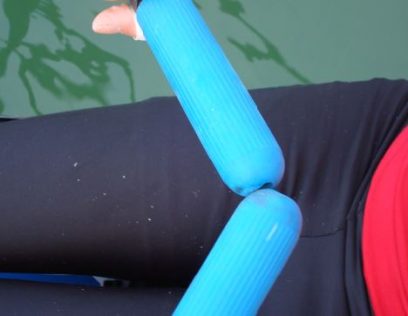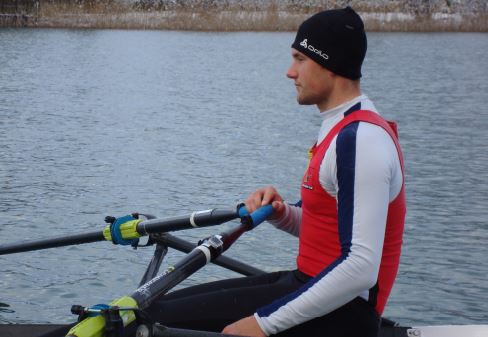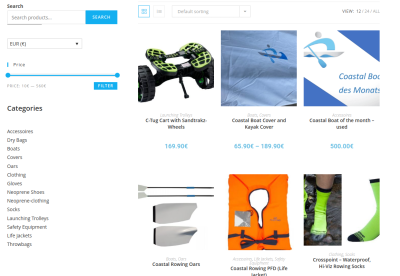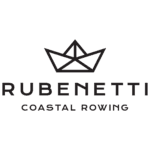Today we have prepared something for you about the special technique of Coastal Boats Rigging and take a closer look at rigging. Here we also explicitly point out the differences to regular rowing, with which you are familiar. You will see why it is somehow the same but also so different.
Rigging your Coastal Boat – What’s important
The post here is intended to give a small introduction to rigging your Coastal Boat, but is by no means complete. The post only reflects our experience and our opinion. This can, of course, differ from other colleagues. It should also be coherent for you. So if you disagree, just try different settings.
Oars:
Many other Coastal Rowers and we prefer short sculls as they are easier to maneuver through the waves. Read our blog on Coastal oars for more on this. After all, this is a wavy and windy experience with possible surprises. In our opinion, a shorter scull is easier to guide and doesn’t feel as heavy. As a result, you are generally more agile and quicker to react. An investment is, therefore, worthwhile. A long oar from the boathouse for shallow water boats will make the ride a slow, lumbering experience. You’re likely to get stuck on waves more often, catch more crabs, and just have a longer “stick” in the water. With a shorter rudder, you can translate strokes a little faster, which prevents you from over speeding when the boat bounces or pushes against the wind.
My boats are currently set to an oar length of 286 cm. A shorter boat I am “playing” with, currently more in the 284-288 cm range. Try a slightly shorter or longer length. 284-286 cm is a good average. However, if you already have oars for shallow water, you can use those as well – just take a few inches off the handles. Most sculls today are “customizable”. We’ve blogged about soft and hard sculls as well.
As for the length of the inside lever, you can go pretty far here. We usually row between 88.5-90 cm. This helps keep the propulsion light. Always keep in mind that a coastal boat weighs 35 kg, about three times as much as an ordinary rowboat. It also carries water in the foot area. Occasionally, some water in the hull as well.
Oarlock height:
The height of the oarlocks can vary greatly. Oarlocks should generally be a little higher on the coast than on the river. However, 18-20 cm, measured at the roller seat, should be enough. World Rowing also recommends this. In general, leave yourself room when rowing on the coast. It should not be too narrow because you need space to lift out and to roll forward. It’s better to risk an air strike than to get stuck with your rudder on a wave or catch a crab.
Width of the outrigger:
Our recommendation: go pretty wide out here. World Rowing recommends a little less for the Beach Sprint, but we are in the recreational and masters area here. Also, you are only rowing 500 m in the Beach Sprint. Our tip is to aim for a range of 160-164 cm. This means that your setting is close to the maximum length that an outrigger swing allows at all. Maybe you just adjust the instep to different lengths and see what you feel comfortable with.
Foot stretcher:
As a general rule, the angle should be about 42-45 degrees from horizontal. The rower should be able to get his/her heels on the board under the shoes as the drive progresses. This is related to the flexibility of the ankles. The stiffer the ankle, the flatter the footplate should be to accommodate the rower. We like a more flat foot stretcher. It doesn’t put as much stress on our heels and tendons.
Foot stretcher adjustment:
Also, if you’re familiar with German, check the post we wrote a few years ago. It describes well where the position of the foot stretcher should be. Put your feet on the board and extend your legs. Then go into the finish, which is about 90–100 degrees. Pull both sculls towards you with one hand. You should still be able to fit a “fist” between your abdomen and the oar. Stay within the prone position. 90–100 degrees is enough. Again, as with all Coastal Rowing adjustments, leave yourself space!

Sure, you can discuss the whole thing controversially. But we prefer a rather shorter stroke to handle the boat better. On the coast, it is helpful for the control of the boat to have a somewhat “wider and stable” upper body in the finish. Good boat handling will lead to faster boat speed.
So: leave yourself plenty of room at the finish. You may know precisely how to position yourself on the flat water boat. Do it the same way, but leave a little more room for the back position.
Identical, but different!
Even though rowing and coastal rowing are almost identical in stroke sequence, there are differences:
In coastal rowing, keep the following in mind: when you pull your hands past your hips and ribs in the finish, waves can always disrupt the stroke sequence at that stage. It’s wobbly; it’s wonky. So there should be enough room to move in all directions, so your hands don’t get caught on your body during waves. The sculls can get caught in the waves, and the eddies of the rip current can shake you up pretty well. You want to avoid catching a crab in rough water, getting caught, or even capsizing. With more room, you can move your hands more freely without getting caught on your body. You’ll be safer on the move, stay focused, and therefore faster.

Coastal Boats Rigging Conclusion: Fun Factor is Safety Factor
Fun and safety are paramount. Choose a soft and “easy” variation of boat setup. Coastal rowing is all about having fun rowing. You want to manage the waves and ultimately control them. That’s where a shorter, lower gear ratio makes it easier. Above all, it gives you more perceived safety on the water.
Are you slower with a soft setting? Probably not. Your row along the coast has so many facets, waves, and wind directions that you can row 90% of all areas with this setting. It’s not about rowing in the regatta course. Here, power, equality of stroke, and efficiency are what counts. But for coastal rowing, we need other skills. The flexibility of the stroke length, different stroke numbers, half roll or 3/4 roll are sometimes alternating.
So: don’t let your club coaches or flat water rowers put you off. Softer is more fun and more safety. And if you have any doubts: Just try it out with different settings. Experimenting is good and gives you experience.







